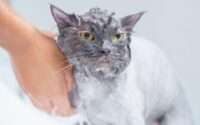Why Are Cats Afraid of Cucumbers? Unveiling the Truth Behind the Fear!
Cats have long been known for their enigmatic behaviors, from quirky antics to peculiar phobias. One such phenomenon that has puzzled pet owners and fascinated internet users is cats’ seemingly irrational fear of cucumbers. This peculiar reaction has sparked countless viral videos and humorous memes, but behind the entertainment lies a genuine curiosity: Why are cats afraid of cucumbers?
In this comprehensive exploration, we delve into the fascinating world of feline psychology to understand the root causes of this peculiar fear. From evolutionary instincts to associative learning, we unravel the complex factors that contribute to cats’ aversion to cucumbers, shedding light on a behavior that has captured the attention of cat lovers worldwide.
The Cucumber Startle Response: Fact or Fiction?
At the heart of the mystery lies the infamous “cucumber prank,” a viral sensation that has taken the internet by storm. The premise is simple: place a cucumber behind a unsuspecting cat while it’s eating or resting, and watch as the feline reacts with a dramatic startle response, often leaping into the air or bolting away in fear.
But is this reaction real, or merely a staged spectacle for online amusement? To answer this question, we turn to scientific research and expert insights to uncover the truth behind cats’ fear of cucumbers. Through careful analysis and observation, we will separate fact from fiction, explore the validity of the cucumber startle response and its implications for understanding feline behavior.
Tracing Cats’ Fear Response Back to Evolutionary Roots
To unravel the mystery of cats’ fear of cucumbers, we must journey back through time to explore their evolutionary roots. Cats, as natural predators, have developed a keen sense of vigilance and wariness towards potential threats in their environment. From lurking predators to unfamiliar objects, cats’ survival instincts play a crucial role in shaping their responses to perceived dangers.
In the wild, cats’ ancestors encountered numerous hazards, including snakes and other predators that posed a genuine threat to their well-being. As such, cats developed a heightened sensitivity to sudden changes in their surroundings, a trait that continues to influence their behavior today. By understanding the evolutionary context of cats’ fear response, we gain valuable insights into why cucumbers, with their elongated shape and green color, may trigger instinctual alarm bells in feline minds.
Predatory Instincts: Hunting, Hiding, and the Fear Factor
Central to cats’ fear of cucumbers is their innate predatory instincts, finely honed through centuries of evolution. Cats are skilled hunters, relying on stealth, agility, and sharp senses to stalk and capture prey. However, this predatory prowess also makes them acutely attuned to potential threats in their environment.
When confronted with an unfamiliar object like a cucumber, cats may perceive it as a potential predator or danger, triggering a primal fear response. This reaction is rooted in cats’ survival instincts, which dictate a cautious approach to unknown stimuli to avoid potential harm.
Drawing upon their ancestral instincts, cats instinctively react to anything that deviates from the norm in their environment. The sudden appearance of a cucumber, with its elongated shape and unusual color, may trigger a cat’s innate suspicion, as it resembles potential threats encountered in the wild. Therefore, what may seem like an innocuous vegetable to humans can evoke a profound fear response in our feline companions.
Understanding Feline Behavior Patterns
Beyond instinctual responses, cats’ fear of cucumbers may also be influenced by associative learning. Cats are intelligent animals capable of forming associations between stimuli and outcomes based on past experiences. If a cat has encountered a cucumber in a context that evoked fear or anxiety, they may generalize this negative association to all cucumbers, even in unrelated situations.
Through associative learning, cats can develop long-lasting fear responses to specific objects or stimuli, including cucumbers. Whether through a single frightening encounter or repeated exposure to cucumbers in distressing situations, cats may learn to avoid these objects as a means of self-preservation.
Moreover, the context in which a cat encounters a cucumber can significantly impact their fear response. For example, if a cucumber is placed unexpectedly behind a cat while they are eating or sleeping, they may associate the cucumber with a sense of vulnerability or threat. This learned association can further reinforce their fear response and contribute to their avoidance of cucumbers in the future.
Visual Characteristics of Cucumbers from a Cat’s Perspective
To understand why cats are afraid of cucumbers, we must consider the visual characteristics of these seemingly innocuous vegetables from a feline perspective. While cucumbers may appear harmless to us, cats perceive the world differently due to their unique visual capabilities and evolutionary adaptations.
Cats possess keen eyesight optimized for hunting and navigating their environment. They are particularly attuned to movement and visual stimuli that resemble potential prey or threats. When confronted with a cucumber, cats may perceive its elongated shape, green color, and sudden appearance as reminiscent of snakes or other predators, triggering a fear response rooted in survival instincts.
Furthermore, the unexpected nature of a cucumber’s appearance can exacerbate a cat’s fear response. Unlike familiar objects in their environment, such as furniture or toys, cucumbers are not part of a cat’s daily visual landscape. Their sudden presence can startle a cat, leading to heightened anxiety and avoidance behaviors.
Additionally, the context in which a cucumber is introduced can influence a cat’s perception of it. For example, placing a cucumber near their food bowl or sleeping area may create a sense of vulnerability or threat, intensifying their fear response.
The Role of Environment and Context in Cat Behavior
The role of environment and context cannot be overstated when it comes to understanding cats’ fear of cucumbers. Cats are highly sensitive to their surroundings, and factors such as stress, novelty, and the element of surprise can significantly influence their reactions to unfamiliar stimuli.
In many cases, the cucumber startle response occurs in unexpected or unfamiliar environments, such as when a cat is engrossed in eating or grooming. The sudden appearance of a cucumber behind them disrupts their sense of security and triggers a fear response. Additionally, cats may be more prone to fear reactions in high-stress situations or when feeling vulnerable, amplifying their response to perceived threats like cucumbers.
Moreover, the context in which a cucumber is introduced plays a crucial role in determining a cat’s reaction. For instance, placing a cucumber near their food bowl or resting area may create a sense of intrusion or threat, leading to heightened anxiety and defensive behaviors. Similarly, if a cat is already feeling stressed or anxious due to changes in their environment or routine, the presence of a cucumber may exacerbate their fear response.
Individual Variability in Cats’ Personalities
Just as every cat has its own distinct personality and preferences, individual variability plays a significant role in cats’ reactions to cucumbers. While some cats may exhibit extreme fear responses at the sight of a cucumber, others may remain unfazed or even curious in the presence of the same stimulus.
Factors such as past experiences, temperament, and socialization can influence how cats perceive and respond to cucumbers and other novel objects. Cats with a history of positive interactions with cucumbers or similar objects may be less likely to exhibit fear responses, while those with negative experiences may be more predisposed to fear and avoidance behaviors.
Additionally, cats’ innate temperament traits, such as boldness or timidity, can shape their reactions to unfamiliar stimuli like cucumbers. Bold cats may approach cucumbers with curiosity or even playfulness, while more cautious cats may view them as potential threats and respond with fear or avoidance.
Socialization experiences during kittenhood can also play a crucial role in shaping cats’ responses to novel objects later in life. Cats exposed to a variety of stimuli in a positive and controlled manner during their formative months may develop greater resilience and adaptability, reducing the likelihood of fear responses to cucumbers and other environmental changes.
Ethical Considerations in Respecting Feline Well-being
As we explore the intriguing phenomenon of cats’ fear of cucumbers, it’s essential to consider the ethical implications of intentionally frightening our feline companions for entertainment purposes. While the cucumber prank may elicit laughter and amusement from humans, it can cause stress, anxiety, and even trauma for cats.
Cats rely on us, their caregivers, to provide a safe and nurturing environment that promotes their physical and emotional well-being. Using scare tactics or deliberately startling cats with cucumbers undermines this responsibility and can have detrimental effects on their mental health.
As responsible pet owners, it’s crucial to prioritize our cats’ welfare and refrain from engaging in activities that may cause them distress or harm. By fostering trust, respect, and mutual understanding in our relationships with our feline friends, we can create an environment where they feel secure and valued.
Practical Tips for Cat Owners to Promote Positive Experiences
For cat owners seeking to ensure their feline friends feel safe and secure in their homes, here are some practical tips to consider:
- Respect your cat’s boundaries and preferences. Pay attention to their body language and avoid placing them in situations that cause fear or discomfort.
- Provide enrichment and mental stimulation to keep your cat engaged and content. Offer toys, scratching posts, and interactive play sessions to satisfy their natural instincts and prevent boredom.
- Create a calming environment by minimizing loud noises, sudden movements, and unfamiliar stimuli that may trigger anxiety in your cat.
- Use positive reinforcement techniques to reward desired behaviors and build trust with your cat. Offer treats, praise, and affection to reinforce good behavior and strengthen your bond.
- Gradually introduce new stimuli, including cucumbers or other novel objects, in a controlled and gentle manner. Allow your cat to investigate at their own pace and provide reassurance if they show signs of anxiety.
By implementing these practical tips and prioritizing your cat’s well-being, you can create a harmonious and fulfilling environment where your feline companion feels safe, happy, and loved.
Conclusion
In conclusion, the mystery of why cats are afraid of cucumbers is a fascinating puzzle that highlights the intricacies of feline behavior and psychology. While the cucumber startle response may appear amusing on the surface, it reflects deeper insights into cats’ evolutionary instincts, associative learning, and individual variability.
By understanding the evolutionary roots, predatory instincts, and environmental factors that contribute to cats’ fear of cucumbers, we gain valuable insights into their complex minds and behaviors. Furthermore, by considering the ethical implications and practical implications for cat owners, we can foster environments that prioritize our feline companions’ well-being and happiness.
As we continue to unravel the mysteries of the feline world, let us approach our interactions with cats with empathy, respect, and compassion. By nurturing strong bonds based on trust and understanding, we can create enriching and fulfilling relationships with our beloved feline friends.
Frequently Asked Questions
Why are cats afraid of cucumbers?
Cats’ fear of cucumbers is often attributed to their natural instincts and the sudden appearance of unfamiliar objects resembling snakes.
Is it harmful to scare my cat with a cucumber?
While it may seem harmless, intentionally startling your cat with a cucumber can cause stress and anxiety, potentially harming your cat’s well-being.
Are all cats afraid of cucumbers?
Not all cats exhibit fear of cucumbers. However, many cats may startle or exhibit cautious behavior when encountering unfamiliar objects, including cucumbers.
How can I help my cat overcome its fear of cucumbers?
Gradual desensitization, positive reinforcement, and creating a safe environment can help your cat overcome its fear of cucumbers over time.
Are there other objects that cats are commonly afraid of?
Cats may exhibit fear or apprehension towards various objects, including vacuum cleaners, loud noises, and sudden movements.
Can fear of cucumbers indicate an underlying health issue in my cat?
In most cases, fear of cucumbers is a natural response and does not indicate an underlying health issue. However, if your cat displays excessive fear or anxiety, it’s essential to consult with a veterinarian.
Why do cats react differently to cucumbers compared to other vegetables?
Cats’ reactions to cucumbers may be influenced by their resemblance to snakes, which trigger a primal fear response in many felines.
Is it advisable to use cucumbers as a training tool for my cat?
Using cucumbers as a training tool is not recommended, as it can cause stress and anxiety in your cat, potentially damaging the bond between you and your pet.
Can kittens be afraid of cucumbers too?
Kittens may exhibit fear of cucumbers, although their reactions may vary based on their individual temperament and previous experiences.
Are there any safety precautions to consider when introducing cucumbers to my cat?
To ensure your cat’s safety, always supervise interactions with cucumbers and avoid placing them in areas where your cat may feel trapped or cornered. Additionally, be mindful of any signs of stress or discomfort and remove the cucumber if necessary.






